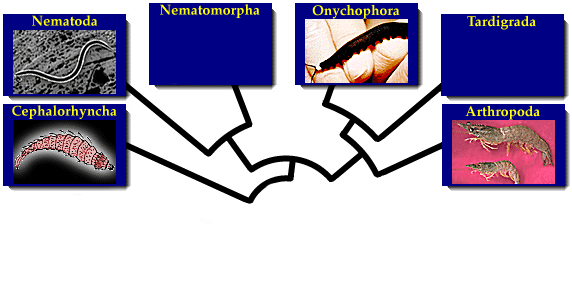
The Ecdysozoa comprise one of the major groups within the animal kingdom, and it is also the largest since it includes both the arthropods (insects, spiders, and crustaceans) and the nematodes. The Ecdysozoa is one of the two large subdivisions within the Protostomia, a group in which the mouth develops from the first opening to develop in the embryo. In turn, the Protostomia belongs to a larger group within the Animalia called the Bilateria, because these animals are bilaterally symmetrical, with a left and a right side to their bodies.

Unlike other animals with skeletons who build their body's support from minerals, an ecdysozoan builds a cuticle, an outer layer of organic material that functions as its skeleton. This means that the skeleton can be built thinner and lighter than in other animals, and does not require a source of minerals for its construction. Also a mineral skeleton requires joints to allow flexibility, whereas an organic covering can be flexible if it is thin enough.
The name Ecdysozoa refers to the fact that many members of this group regularly shed their cuticle, a process called ecdysis that is controlled hormonally by a class of steroids appropriately called ecdysteroids. If you have ever seen an insect crawl out of its old skin, or a butterfly leaving its chrysalis, then you have seen this shedding take place. This ability to shed the outer skeleton has opened up developmental options for ecdysozoans that other animals with skeletons do not have available to them. This is in part because of the limitations a mineral skeleton imposes on an animal; growth can only occur by adding more mineral to the existing skeleton, which limits the animal's form as it grows. While many ecdysozoans also maintain their basic form throughout their life, molting removes this limitation. Some ecdysozoans have taken advantage of this, especially the insects. Most groups of insects undergo partial or complete metamorphosis before reaching the adult stage, and the larva may look very different from the final adult and even live in a completely different environment.
Also unlike basal animals, deuterostomes, and lophotrochozoans who reproduce by simply releasing mass quantities of egg and sperm cells into the water in the hopes that fertilization will occur, many species of ecdysozoans have separate sexes who come together and copulate. The sperm is either delivered to the female's body or is deposited directly onto the eggs as they are released. This trait greatly increases the chances of successful fertilization, and has evolved independently in the vertebrates.
The phylogeny above is based on a combination of morphology and 18S RNA; these relationships have been supported by both kinds of data independently. It is not the final word on the relationships between these groups, and there are many competing hypotheses. For now, we prefer this grouping based on the available evidence, but as data continues to accumulate our picture of ecdysozoan relationships may change.


